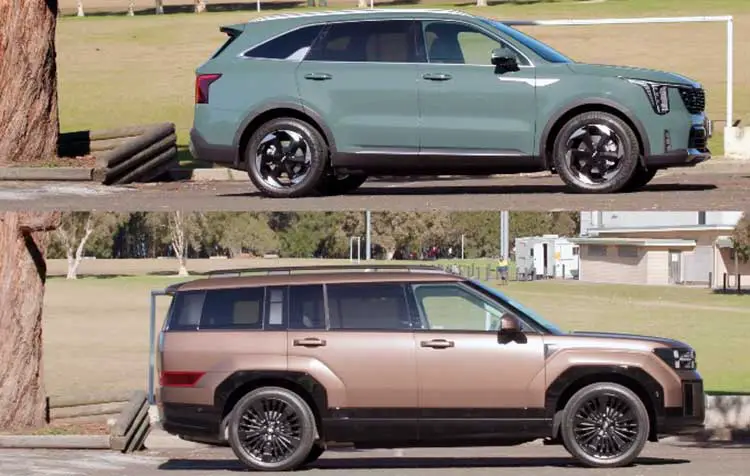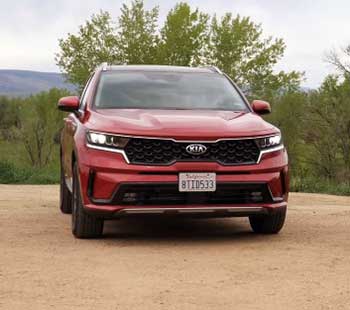As a car enthusiast and a family-oriented driver, I set out to compare two standout hybrid SUVs: the Kia Sorento Hybrid and the Hyundai Santa Fe Hybrid. My goal is to help you decide which of these midsize, family-friendly vehicles best fits your needs. By exploring their performance, design, technology, and value, I’ll share a detailed, first-person analysis of their strengths and weaknesses.
Whether you’re prioritizing fuel efficiency, space, or tech, this article will guide you toward an informed choice with a conversational, real-world perspective.

Comparison Table: Kia Sorento Hybrid vs. Hyundai Santa Fe Hybrid
| Feature | Kia Sorento Hybrid | Hyundai Santa Fe Hybrid |
| Starting MSRP | $38,690 (EX trim) | $39,295 (SEL trim) |
| Powertrain | 1.6L turbo 4-cylinder + electric motor, 227 hp, 258 lb-ft | 1.6L turbo 4-cylinder + electric motor, 231 hp, 271 lb-ft |
| Fuel Economy (MPG) | 36 combined (FWD), 34 combined (AWD) | 36 combined (FWD), 35 combined (AWD) |
| Cargo Space | 12.6 cu.ft. (behind 3rd row), 75.5 cu.ft. (max) | 14.6 cu.ft. (behind 3rd row), 79.6 cu.ft. (max) |
| Seating Capacity | 6 (captain’s chairs) or 7 (bench option) | 7 (bench) or 6 (captain’s chairs in Calligraphy) |
| Warranty | 5-yr/60,000-mile limited, 10-yr/100,000-mile powertrain | 5-yr/60,000-mile limited, 10-yr/100,000-mile powertrain |
| Safety Rating (NHTSA) | 4/5 stars | 4/5 stars |
| Infotainment | 12.3-inch touchscreen, wireless Apple CarPlay/Android Auto | 12.3-inch touchscreen, wireless Apple CarPlay/Android Auto |
| Towing Capacity | Up to 2,000 lbs (3,500 lbs with towing package) | Up to 2,000 lbs |
My Journey with Hybrid SUVs
The automotive world’s shift toward hybrids has always fascinated me. As someone who’s driven everything from zippy coupes to rugged trucks, I’m drawn to hybrid SUVs for their blend of efficiency and versatility. The Kia Sorento Hybrid and Hyundai Santa Fe Hybrid, both from the Hyundai Motor Group, compete fiercely in the midsize SUV market, offering family-friendly space, fuel savings, and modern tech.
My week-long test drives of these vehicles gave me a front-row seat to their strengths and quirks. Comparing them felt like a natural step to help you navigate this evolving segment, balancing practicality with a touch of excitement.
Exterior Design and First Impressions
Pulling up in the Kia Sorento Hybrid, I was struck by its sleek, athletic stance. The 2025 facelift brought sharper lines, a bold tiger-nose grille, and amber-tinted LED daytime running lights that give it a sporty yet approachable vibe. It feels cohesive with Kia’s lineup, blending style and accessibility.

When I parked it next to the Hyundai Santa Fe Hybrid, the contrast was striking.
The Santa Fe’s boxy, retro-inspired design, with its massive grille and H-shaped LED lights, channels rugged classics like Land Rovers.
It’s bold and polarizing—some love its chunky aesthetic, others find it too aggressive. I leaned toward the Sorento’s smoother curves for universal appeal, but the Santa Fe’s vibrant color options (like Earthy Brass) added flair.
Kia Sorento Hybrid Pros:
- Sleek, sporty design; less polarizing; cohesive Kia styling.
Kia Sorento Hybrid Cons:
- Less distinctive than Santa Fe; some trims lack LED taillights.
Hyundai Santa Fe Hybrid Pros:
- Bold, retro-modern look; premium feel in Calligraphy trim; vibrant colors.
Hyundai Santa Fe Hybrid Cons:
- Boxy design may not suit all tastes; premium paint colors cost extra ($695).
Interior Comfort and Space
Stepping into the Sorento Hybrid’s cabin felt like entering a plush, sporty sanctuary. The EX trim I tested had quilted leather seats, a panoramic sunroof, and a Bose audio system that made my playlists pop. The dual 12.3-inch screens form a seamless panoramic display, but the dual-function climate and infotainment touch panel was a hassle—adjusting the volume often changed the temperature by mistake.
The Sorento’s second-row legroom (40.7 inches) was comfy, ideal for kids or short trips, but the third row’s 29.6 inches felt cramped, better suited for children than adults. Cargo space (12.6 cu.ft. behind the third row, 75.5 cu.ft. max) handled groceries and gear well, though it felt snug for bulkier items.
The Santa Fe Hybrid, on the other hand, felt like a step into the future. Its Calligraphy trim boasted decadent materials, like a suede-look headliner and ambient lighting that added a touch of class. The center console’s open storage tray was a game-changer for stashing my backpack, and the dual wireless charging pads kept my devices powered without clutter.
The Santa Fe’s interior felt airier, with slightly more legroom (44.4 inches in the front vs. Sorento’s 41.4) and a larger cargo area (14.6 cu.ft. behind the third row, 79.6 cu.ft. max). However, the third row’s 30.0 inches was still tight for adults, and the infotainment’s reliance on touch for climate controls was distracting.
Kia Sorento Hybrid Pros:
- Plush, sporty cabin; high-quality Bose audio; versatile seating (bench or captain’s chairs).
Kia Sorento Hybrid Cons:
- Cramped third row; frustrating touch panel.
Hyundai Santa Fe Hybrid Pros:
- Spacious, luxurious interior; innovative storage solutions; more cargo space.
Hyundai Santa Fe Hybrid Cons:
- Touch-only climate controls; third row not adult-friendly.
Performance and Driving Experience

Both SUVs share a similar powertrain: a 1.6-liter turbocharged four-cylinder paired with an electric motor and a six-speed automatic.
The Sorento Hybrid produces 227 horsepower and 258 lb-ft of torque, while the Santa Fe Hybrid edges it out with 231 horsepower and 271 lb-ft.
On the road, the difference was subtle but noticeable.
The Santa Fe felt peppier during highway merges, with smoother throttle response. The Sorento, however, handled corners with a nimbler, almost car-like feel, thanks to its Australian-tuned suspension. It was a joy on twisty roads, though its ride was slightly harsher over bumps.
I drove both through city traffic and open highways, and the Santa Fe’s ride was noticeably more refined, soaking up rough patches better. Its brakes, however, felt soft under aggressive driving, which was a minor letdown. The Sorento’s regenerative braking paddles (available in Sport mode) were a fun touch, letting me fine-tune energy recovery.
I tested both in city traffic and on highways, and their hybrid systems switched seamlessly between electric and gas power. The Sorento’s all-wheel-drive option added confidence on wet roads, while the Santa Fe’s Terrain Mode selector (for snow or mud) was handy for light off-roading. Neither is a performance beast, but they balance family needs with enough zip to keep things engaging.
Kia Sorento Hybrid Pros:
- Nimble handling; regenerative braking paddles; solid AWD performance.
Kia Sorento Hybrid Cons:
- Harsher ride over bumps; slightly less power.
Hyundai Santa Fe Hybrid Pros:
- Smoother ride; stronger torque; versatile Terrain Mode.
Hyundai Santa Fe Hybrid Cons:
- Softer brake feel; AWD less agile than Sorento.
Technology and Infotainment
Kia and Hyundai pack their SUVs with tech, and these hybrids are no exception. The Sorento Hybrid’s 12.3-inch touchscreen infotainment system was a standout—crisp, responsive, and supporting wireless Apple CarPlay and Android Auto. I loved the cable-free connectivity, and the customizable widgets made navigation a breeze.
The 12.3-inch digital gauge cluster (on higher trims) was clear even in bright sunlight, but the dual-function touch panel for climate and media controls was a pain. I’d accidentally crank the AC while skipping tracks, which grew frustrating.
The Santa Fe Hybrid matches the Sorento with its own 12.3-inch touchscreen, also supporting wireless CarPlay/Android Auto. Its interface felt slightly snappier, with a cleaner layout for media and navigation. The Calligraphy trim’s head-up display projected speed and directions onto the windshield, keeping my eyes on the road—a feature I missed in the Sorento’s lower trims.
The Santa Fe’s fingerprint scanner for driver profiles was a cool, futuristic touch, though I didn’t use it much. Like the Sorento, its reliance on touch controls for climate settings was a drawback, especially while driving.
Kia Sorento Hybrid Pros:
- Vibrant touchscreen; wireless connectivity; clear digital gauges.
Kia Sorento Hybrid Cons:
- Annoying touch panel; head-up display limited to top trims.
Hyundai Santa Fe Hybrid Pros:
- Snappy infotainment; useful head-up display; innovative fingerprint scanner.
Hyundai Santa Fe Hybrid Cons:
- Touch-heavy climate controls; some features exclusive to Calligraphy.
Safety and Driver Assistance
Safety is critical for family SUVs, and both vehicles deliver robust packages. The Sorento Hybrid’s DriveWise suite includes adaptive cruise control with lane centering, blind-spot monitoring, rear cross-traffic alert, and automatic emergency braking. During my drives, the lane-keeping assist was smooth but occasionally overcorrected on curvy roads. The surround-view camera was a lifesaver for tight parking spots, though the Sorento’s 4/5 NHTSA safety rating was a slight letdown compared to top competitors.
The Santa Fe Hybrid shines with a 4/5 NHTSA overall rating, offering extra peace of mind. Its SmartSense suite mirrors the Sorento’s features but adds a blind-spot view monitor that displays a camera feed in the gauge cluster when signaling—a brilliant tool for highway driving. The adaptive cruise control felt more refined, adjusting smoothly in traffic. However, the lane-keeping system could be intrusive, nudging the wheel more aggressively than I preferred. Both SUVs feel safe, but the Santa Fe’s strong IIHS Top Safety Pick rating gives it a slight edge.
Kia Sorento Hybrid Pros:
- Comprehensive safety suite; excellent surround-view camera; intuitive driver aids.
Kia Sorento Hybrid Cons:
- 4/5 NHTSA rating; lane-keeping can overcorrect.
Hyundai Santa Fe Hybrid Pros:
- 4/5 NHTSA rating; blind-spot view monitor; refined adaptive cruise.
Hyundai Santa Fe Hybrid Cons:
- Overzealous lane-keeping; some features limited to higher trims.
Pricing and Value
Pricing is a key factor, and these SUVs are competitively matched. The Sorento Hybrid starts at $38,690 (EX trim), while the Santa Fe Hybrid begins at $39,295 (SEL trim). Fully loaded, the Sorento SX Prestige hit around $47,000, and the Santa Fe Calligraphy neared $50,215. Both offer identical warranties: 5 years/60,000 miles limited and 10 years/100,000 miles powertrain, among the best in the industry.
The Sorento feels like a better value for budget-conscious buyers, packing premium features like leather seats and a sunroof in mid trims. The Santa Fe justifies its price with a more upscale interior and extra cargo space, especially in the Calligraphy trim. If you’re after luxury, the Santa Fe delivers, but the Sorento’s balance of cost and features makes it hard to beat.
Read More: Kia Sorento Hybrid vs. Hyundai Santa Fe Hybrid
Kia Sorento Hybrid Pros:
- Lower starting price; premium features in mid trims; excellent warranty.
Kia Sorento Hybrid Cons:
- Loaded models approach Santa Fe’s price; fewer luxury touches.
Hyundai Santa Fe Hybrid Pros:
- Luxurious top trims; competitive base price; generous warranty.
Hyundai Santa Fe Hybrid Cons:
- Premium trims get pricey; some options cost extra.
Towing and Practicality
For families or adventurers, towing and cargo capacity are key. The Sorento Hybrid tows up to 2,000 pounds standard, but with the optional towing package (AWD models), it reaches 3,500 pounds—enough for a small trailer or camper. Its cargo space (12.6 cu.ft. behind the third row, 75.5 cu.ft. max) handled groceries and sports gear, but the tight third row limited its use for adults.
The Santa Fe Hybrid maxes out at 2,000 pounds of towing, fine for light trailers but behind the Sorento’s upgraded capacity. Its cargo area (14.6 cu.ft. behind the third row, 79.6 cu.ft. max) easily fit bulky items like a stroller. The second row’s one-touch fold feature made loading effortless. The Santa Fe wins for cargo, but the Sorento takes towing.
Kia Sorento Hybrid Pros:
- Higher towing with package; versatile cargo; easy-to-fold seats.
Kia Sorento Hybrid Cons:
- Tight third row; less cargo than Santa Fe.
Hyundai Santa Fe Hybrid Pros:
- Larger cargo area; user-friendly seat folding; spacious second row.
Hyundai Santa Fe Hybrid Cons:
- Lower towing limit; third row cramped for adults.
Fuel Efficiency and Environmental Impact
Both SUVs excel in fuel efficiency, a major draw for eco-conscious drivers. The Sorento Hybrid’s 36 MPG combined (FWD) matched the Santa Fe’s, though I averaged 34 MPG in the Sorento and 35 MPG in the Santa Fe during mixed driving. The Sorento’s lighter curb weight (4,345 lbs vs. Santa Fe’s 4,575 lbs) helped in city traffic, hitting close to 38 MPG in eco mode. The Santa Fe was more consistent on highways, maintaining 34 MPG with AWD.
Their 1.6 kWh (Sorento) and 1.49 kWh (Santa Fe) batteries reduce emissions without needing plug-in charging, simplifying ownership. The Santa Fe’s slightly larger battery offered a marginally longer electric-only range, but the difference was minimal. Both are ideal for cutting fuel costs while keeping SUV practicality.
Kia Sorento Hybrid Pros:
- Excellent fuel economy; lightweight design; no plug-in needed.
Kia Sorento Hybrid Cons:
- AWD drops MPG slightly; short electric range.
Hyundai Santa Fe Hybrid Pros:
- Consistent highway MPG; eco-friendly design; smooth hybrid transitions.
Hyundai Santa Fe Hybrid Cons:
- Heavier weight; limited electric range.
Which One Should You Choose?
After driving both, the choice hinges on your priorities. The Kia Sorento Hybrid is your pick if you want a sporty, value-packed SUV with nimble handling and a lower price. Its sleek design and strong features make it a crowd-pleaser, though the third row and ride quality could improve. The Hyundai Santa Fe Hybrid shines for its luxurious interior, bold styling, and smoother ride. Its cargo space and safety rating are bonuses, but the higher price and polarizing look might give you pause.
For me, the Sorento’s balance of cost and features edged out, especially for budget-conscious families. But the Santa Fe’s Calligraphy trim tempted me with its premium vibe. You’ll need to test-drive both to feel what clicks—style, space, or savings.
Read More: Kia Sorento vs. Volkswagen Atlas
Frequently Asked Questions (FAQ)
Yes, it’s a great choice for its luxurious interior, strong safety ratings, and solid fuel economy, especially if you value cargo space and premium features.
The Sorento Hybrid benefits from Kia’s strong reliability reputation and a 10-year/100,000-mile powertrain warranty, making it a dependable option.
It depends: the Sorento offers better value and handling, while the Santa Fe excels in luxury and cargo space. Test both to decide.
The Kia Sorento is the closest equivalent, sharing similar size, hybrid powertrain, and features, though with sportier styling and handling.
Conclusion
Comparing the Kia Sorento Hybrid and Hyundai Santa Fe Hybrid was a revealing journey, and I hope it’s helped you narrow your choice. Both SUVs deliver efficiency, family-friendly features, and modern tech, but they cater to different tastes. The Sorento’s sporty edge and value make it ideal for practical buyers, while the Santa Fe’s bold design and upscale cabin appeal to those craving luxury. Whichever you choose, you’re getting a versatile hybrid that balances performance and practicality. Take them for a spin, and let me know which one wins your heart!

